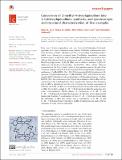Files in this item
Conversion of 2-methyl-4-styrylquinolines into 2,4-distyrylquinolines : synthesis, and spectroscopic and structural characterization of five examples
Item metadata
| dc.contributor.author | Vera, Diana R. | |
| dc.contributor.author | Ardila, Diana M. | |
| dc.contributor.author | Palma, Alirio | |
| dc.contributor.author | Cobo, Justo | |
| dc.contributor.author | Glidewell, Christopher | |
| dc.date.accessioned | 2023-02-23T10:30:14Z | |
| dc.date.available | 2023-02-23T10:30:14Z | |
| dc.date.issued | 2023-03-01 | |
| dc.identifier | 283458283 | |
| dc.identifier | 6951e81b-b790-4aa7-b6cd-4942b71f8e38 | |
| dc.identifier | 85149566922 | |
| dc.identifier.citation | Vera , D R , Ardila , D M , Palma , A , Cobo , J & Glidewell , C 2023 , ' Conversion of 2-methyl-4-styrylquinolines into 2,4-distyrylquinolines : synthesis, and spectroscopic and structural characterization of five examples ' , Acta Crystallographica Section C Structural Chemistry , vol. 79 , no. Part 3 , C79 , pp. 94-103 . https://doi.org/10.1107/s2053229623001432 | en |
| dc.identifier.issn | 2053-2296 | |
| dc.identifier.uri | https://hdl.handle.net/10023/27036 | |
| dc.description | Funding for this research was provided by: Vicerrectoría de Investigación y Extensión of the Industrial University of Santander (grant No. 2680). | en |
| dc.description.abstract | Four new 2,4-distyrylquinolines and one 2-styryl-4-[2-(thiophen-2-yl)vinyl]quinoline have been synthesized using indium trichloride condensation reactions between aromatic aldehydes and the corresponding 2-methylquinolines, which were themselves prepared using Friedländer annulation reactions between mono- or diketones and (2-aminophenyl)chalcones: the products have all been fully characterized by spectroscopic and crystallographic methods. 2,4-Bis[(E)-styryl]quinoline, C25H19N, (IIa), and its dichloro analogue, 2-[(E)-2,4-dichlorostyryl]-4-[(E)-styryl]quinoline, C25H17Cl2N, (IIb), exhibit different orientations of the 2-styryl unit relative to the quinoline nucleus. In each of the 3-benzoyl analogues {2-[(E)-4-bromostyryl]-4-[(E)-styryl]quinolin-3-yl}(phenyl)methanone, C32H22BrNO, (IIc), {2-[(E)-4-bromostyryl]-4-[(E)-4-chlorostyryl]quinolin-3-yl}(phenyl)methanone, C32H21BrClNO, (IId), and {2-[(E)-4-bromostyryl]-4-[(E)-2-(thiophen-2-yl)vinyl]quinolin-3-yl}(phenyl)methanone, C30H20BrNOS, (IIe), the orientation of the 2-styryl unit is similar to that in (IIa), but the orientation of the 4-arylvinyl units show considerable variation. The thiophene unit in (IIe) is disordered over two sets of atomic sites having occupancies of 0.926 (3) and 0.074 (3). There are no hydrogen bonds of any kind in the structure of (IIa), but in (IId), a single C—H...O hydrogen bond links the molecules into cyclic centrosymmetric R22(20) dimers. A combination of C—H...N and C—H...π hydrogen bonds links the molecules of (IIb) into a three-dimensional framework structure. A combination of three C—H...π hydrogen bonds links the molecules of (IIc) into sheets, and a combination of C—H...O and C—H...π hydrogen bonds forms sheets in (IIe). Comparisons are made with the structures of some related compounds. | |
| dc.format.extent | 10 | |
| dc.format.extent | 6087799 | |
| dc.language.iso | eng | |
| dc.relation.ispartof | Acta Crystallographica Section C Structural Chemistry | en |
| dc.subject | Heterocyclic compounds | en |
| dc.subject | Synthesis | en |
| dc.subject | Quinolines | en |
| dc.subject | Styrylquinolines | en |
| dc.subject | NMR spectroscopy | en |
| dc.subject | Crystal structure | en |
| dc.subject | Molecular conformation | en |
| dc.subject | Hydrogen bonding | en |
| dc.subject | Supramolecular assembly | en |
| dc.subject | Privileged scaffold | en |
| dc.subject | QD Chemistry | en |
| dc.subject | DAS | en |
| dc.subject | MCC | en |
| dc.subject.lcc | QD | en |
| dc.title | Conversion of 2-methyl-4-styrylquinolines into 2,4-distyrylquinolines : synthesis, and spectroscopic and structural characterization of five examples | en |
| dc.type | Journal article | en |
| dc.contributor.institution | University of St Andrews. School of Chemistry | en |
| dc.identifier.doi | 10.1107/s2053229623001432 | |
| dc.description.status | Peer reviewed | en |
This item appears in the following Collection(s)
Items in the St Andrews Research Repository are protected by copyright, with all rights reserved, unless otherwise indicated.

